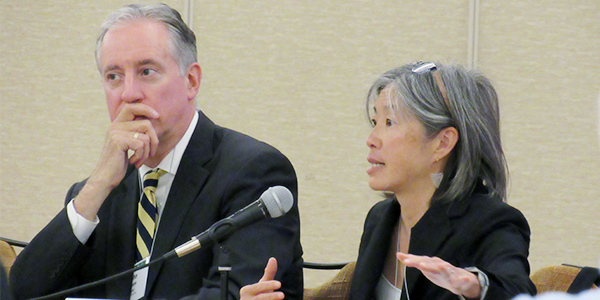By Amanda Durish Cook
INDIANAPOLIS — Most state regulators think it is time to begin preparing for a 100% clean energy future, based on discussions at the National Association of Regulatory Utility Commissioners’ 2019 Summer Policy Summit.
In real-time voting during a panel Monday, 75% of regulators and industry staffers in the audience said it was time to begin prepping for a 100% clean energy future, with 4% saying the question could wait two to five years, 10% saying not for a while and 11% deeming the preparations not a priority.
Energy consultant Debbie Lew said 100% clean energy is within reach now.
“You can do 100% clean energy today; it just depends on how expensive it will be,” said Lew, who said the expense of synchronous condensers, grid-forming inverters and other power electronics quickly adds up. The effectiveness of a proliferation of four-hour batteries on resource adequacy also has a saturation point, she said.
The question remains, she continued, as to how smart and cost-conscious regulators and utilities are going to be during the transition. More accurate forecasting, price sensitive-demand response and effective curtailments can smooth the changeover, Lew said.
A 100% renewable future can be facilitated by larger regions with faster trading, a varied storage portfolio, demand-side flexibility, better forecasting and intermittent resources sometimes used for ancillary service dispatch, she said. “We tend to think of curtailment of wind or solar PV as a bad or ugly thing, but if we use that in combination with forecasting, we can use that as a reserve product. … It’s a technology that’s available right now.”
Lew said she can’t yet tell if there will be a need for regional energy markets after such a transition, but capacity markets could become more vital as seasonal, on-demand capacity becomes more necessary to cover intermittent resources.
“We’re really good at running energy markets, but is there much of a place for markets with zero-marginal-cost energy?” Lew asked.
Hawaii Public Utilities Commission Chair James Griffin said regulatory changes are a vital component to reaching 100% clean energy goals.
But Xcel Energy Director of Energy and Environmental Policy Jeff Lyng said a regulatory overhaul isn’t necessary to make the transition.
“Utilities have demonstrated that they can innovate and deploy [renewables] at scale,” Lyng said. He added, however, that small rule changes could be appropriate, in addition to the timely approval of pilots and generation projects and a continued focus on emissions control.
Lyng said Xcel worked with climate scientists to develop its 2050 zero-carbon goals, which line up with the target to keep global surface temperatures from rising beyond 2 degrees Celsius.
Griffin said the Hawaiian islands, which are especially susceptible to the risks of climate change, can’t afford to wait on high-tech solutions that will facilitate 100% renewable energy.
“Every time I’m told to slow down, I remind others that the status quo is the problem,” Griffin said.
Clean Air Task Force Executive Director Armond Cohen pushed back on the oft repeated conclusion that an 80% renewable mix is doable now, but a 100% renewable takeover remains out of reach. He said 100% clean energy is not an impossibility — it will just be expensive. Cohen also said he supports bills for 100% clean energy over bills that call for 100% renewable energy.
“I think that if we keep out options open, it’s totally doable,” Cohen said. “It’s going to be a lot of capex run very seldomly. … It gets very expensive very fast.” Cohen said an ideal, albeit wholly unrealistic solution, would be to cover the remaining 20% with zero-marginal-cost storage devices.
Multiple panelists repeated the call for federal-level carbon pricing to prompt more technology investment to facilitate renewable integration.
“Politics is going to be a big part of getting from here to there,” Sustainable FERC Project Director John Moore said.
He also said if he could have his way, the entire Eastern Interconnection would be consolidated into a single RTO to pave the way for renewables; however, he admitted such a scenario is unlikely.






